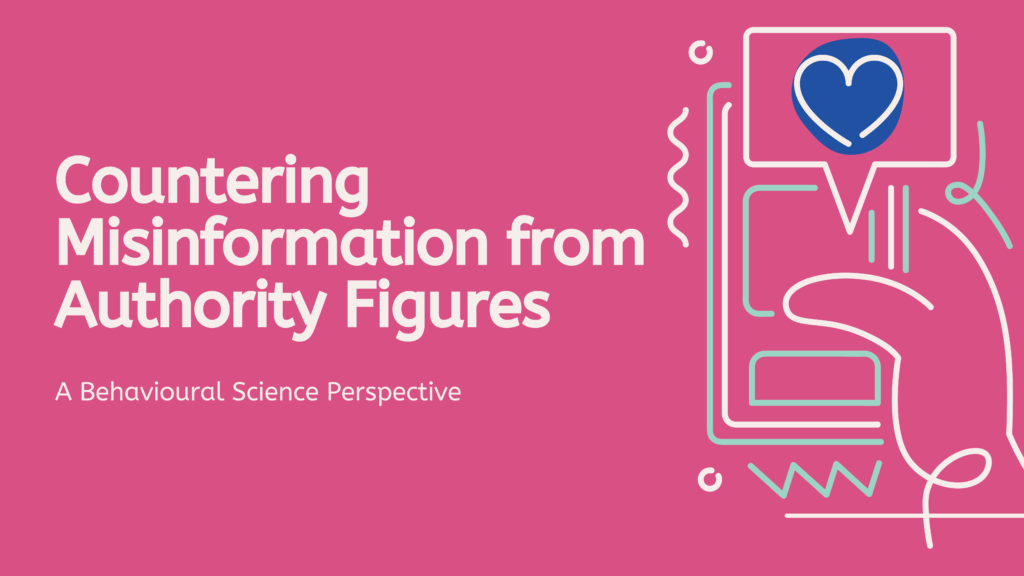We care about your privacy

When a social media influencer shares a conspiracy theory, it’s frustrating. But when the misinformation comes from a figure of authority (e.g. a health minister, a CEO, a political leader) it’s something else entirely.
People tend to place greater trust in those with status, titles, or expertise. That trust is a heuristic that saves us from having to fact-check everything ourselves. But it also creates risk. When those in power spread misinformation, the falsehood carries the weight of credibility and can quickly cascade across communities, institutions, and even countries.
So how do we push back when the messenger is as powerful as the message? Behavioural science offers some answers. In this blog, I’ll explore four insights that help explain and counter the spread of falsehoods from authority figures: inoculation theory, motivated reasoning, source credibility, and descriptive norms. Along the way, I’ll draw on research that shows how each of these tools has been applied in practice, and what we can learn from it.
Inoculation theory was first developed by William McGuire in the 1960s, but it has found a new lease of life in today’s misinformation-saturated world. The key insight is the same: if people are forewarned, they are forearmed.
Recent research shows how this can work at scale. Roozenbeek et al (2022) tested 90-second videos on YouTube that explained common manipulation techniques like scapegoating or false dichotomies. Viewers who saw just one of these clips became significantly better at recognising misinformation, and crucially, this held across political divides.
Interactive tools also help. The online game Bad News gives players a chance to step into the shoes of a fake-news creator. By learning the tricks from the inside, players come out more resistant to those same tactics in real life (Basol et al, 2020; Roozenbeek & van der Linden, 2019).
The lesson is simple: if we know a contentious issue is coming, for example a vaccine rollout, a corporate merger, or an election, prebunking can build resilience before a misleading claim from an authority figure even lands. I have another blog focusing on Inoculation Theory that you can access here.
Of course, not all misinformation is equal. When a trusted figure makes a claim that resonates with our values or identity, people often cling to it. This is motivated reasoning, which is the tendency to accept information that confirms what we want to believe. We process information defensively to preserve our long-held beliefs (Bartholomew Eldredge et al., 2016).
The implication is clear: blasting facts at people rarely works when identity is at stake. Instead, corrections are more effective when they come from an in-group source. For example, a correction from a local community leader or a respected peer may land where an outside expert’s voice will be dismissed. In other words, combating authority-driven misinformation is not just about what you say, but who says it.
Authority figures benefit from a credibility shortcut. People assume that they have expertise and are trustworthy. That’s why misinformation from these figures is so potent. But credibility can be challenged.
Van der Linden’s research on climate communication shows that highlighting scientific consensus is a powerful corrective tool. Simply stating that “97% of climate scientists agree” reduces public misperceptions and makes people less likely to believe isolated dissenting voices (Cook et al, 2017).
This matters when an influential leader presents their opinion as though it’s widely accepted. By making the true consensus visible, we can reduce the credibility gap.
Misinformation thrives when people think everyone else believes it. These are known as descriptive norms, our perception of what others do.
Experiments show that when corrections are visible (for example, when peers flag misleading posts online) others are less likely to believe or share the misinformation. In a study using mock Facebook feeds, participants who saw corrective comments were significantly less likely to rate the false content as accurate or to indicate they would share it (Bode & Vraga, 2018).
Similarly, consensus messaging helps. Making the true majority view visible (such as “97% of climate scientists agree that humans are causing global warming”) reduces public misperceptions by correcting false descriptive norms.
In other words: showing that most people, or most experts, reject a false claim reframes the misinformation as an outlier, not the norm. Over time, this can help create a cultural immune system that makes it harder for even high-status figures to distort the truth.
Countering misinformation from an authority figure is not easy. But behavioural science gives us tested tools:
Basol, M., Roozenbeek, J., & van der Linden, S. (2020). Good news about Bad News: Gamified inoculation boosts confidence and cognitive immunity against fake news. Journal of Cognition, 3(1), 2. https://doi.org/10.5334/joc.91
Bode, L., & Vraga, E. K. (2018). See something, say something: Correction of global health misinformation on social media. Health Communication, 33(9), 1131–1140. https://doi.org/10.1080/10410236.2017.1331312
Cook, J., Lewandowsky, S., & van der Linden, S. (2017). The consensus handbook. University of Queensland. Retrieved from https://climatecommunication.gmu.edu/all/the-consensus-handbook/
McGuire, W. J. (1964). Inducing resistance to persuasion: Some contemporary approaches. Advances in Experimental Social Psychology, 1, 191–229. https://doi.org/10.1016/S0065-2601(08)60052-0
Roozenbeek, J., & van der Linden, S. (2019). Fake news game confers psychological resistance against online misinformation. Palgrave Communications, 5, 65. https://doi.org/10.1057/s41599-019-0279-9
Roozenbeek, J., van der Linden, S., & Lazer, D. (2022). Psychological inoculation improves resilience against misinformation on social media. Science Advances, 8(34), eabo6254. https://doi.org/10.1126/sciadv.abo6254
—
👉🏾 How skilled are you at designing for change? Start with the FREE assessment: https://lnkd.in/dK7YPKgR
👉🏾 Join my mailing list for exclusive insights and content! subscribepage.io/rUxP5k